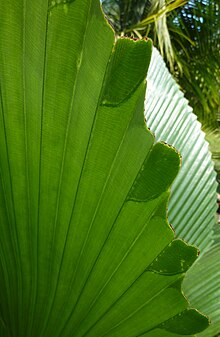Johannesteijsmannia
| Johannesteijsmannia | ||||||||||||
|---|---|---|---|---|---|---|---|---|---|---|---|---|

Johannesteijsmannia altifrons in North Sumatra |
||||||||||||
| Systematics | ||||||||||||
|
||||||||||||
| Scientific name | ||||||||||||
| Johannesteijsmannia | ||||||||||||
| HEMoore |
Johannesteijsmannia is a palm genus native to Southeast Asia. They are easily recognized by their diamond-shaped, undivided leaves.
features
The representatives are showy trunkless or short-stemmed, reinforced palms. They are several times blooming and hermaphroditic. The trunk is very short, prostrate or upright. The leaf scars are ring-shaped.
The chromosome number is 2n = 34.
leaves
The leaves are large, undivided and diamond-shaped. They are ribbed feather-shaped. The leaf sheath is initially tubular, later dries up and disintegrates into a mass of fibers. The petiole is distinct, almost triangular in cross-section, flattened adaxially and reinforced with small, sharp teeth along the edges. Very young petioles are hairy. An adaxial hastula is present on growing leaves , but disappears as the leaves ripen. The costa stretches almost to the tip of the leaf, it stands out more clearly on the underside of the leaf than on the upper side. The leaf blade is pinnately ribbed, and glabrous, or densely hairy white on the underside.
Inflorescences
The inflorescences are between the leaves (interfoliar). They are short and mostly partially covered by dead leaf material. The inflorescence is branched one to five times. The peduncle is clearly developed, mostly curved and hairy. The cover sheet is Roehrig, somewhat inflated, two-keeled and usually densely hairy. The bracts on the peduncle are conspicuous, up to seven in number and initially cream-colored, later cinnamon-brown. They are tubular, puffed up and stand distant. All bracts and the cover sheet tear on the side facing the ground, allowing the inflorescence to bend down. The inflorescence axis is shorter than the stem, the side branches stand in the axils of small, triangular bracts . The side branches are often close together. The flower-bearing axes (rachillae) are either very thick, then there are only three to six, or they are very numerous and slender. They have small bracts for the flowers in a spiral arrangement. The flowers are solitary or in coils of two to four flowers. The flowers stand on short elevations or are sessile.
blossoms
The flowers are hermaphrodite, cream-colored and strongly scented. The calyx is cup-shaped with three flat, bald, triangular lobes. The crown is divided to two-thirds or almost to the base into three thin or very thick, fleshy, triangular, bald, sometimes densely papillary , valvate corolla lobes. The six stamens are epipetal, have very broad, fleshy filaments that are fused to a ring at the base and are abruptly narrowed to short, very narrow tips. The anthers are very small, rounded, and intrors.
The gynoeceum consists of three carpels . These are free at the base and connected at the tips so that a common, long, slender stylus is created. The scar is punctiform. The ovule sits basal and is anatropic.
The pollen is ellipsoidal, bisymmetrical or slightly asymmetrical. The germ opening is a distal sulcus. The longest axis measures 20 to 32 microns.
Fruits and seeds
The fruit is round and usually develops from just one of the three carpels. Sometimes two or all three develop, then the fruit is two- or three-lobed. The epidermis of the fruit dies early in development, the mesocarp then ruptures to form thick, corky, pyramidal warts and is auburn in color. The endocarp is moderately thick and crusty. The seed sits at the base , the endosperm is homogeneous, but a mass of the seed coat penetrates the endosperm at the base.
Distribution and locations
The genus occurs only in Southeast Asia. One species ( Johannesteijsmannia altifrons ) is quite widespread and can be found in southern Thailand , western Malaysia , Sumatra and western Borneo . The other three species are endemic to West Malaysia.
All are plants of the undergrowth of primary rainforests. They seem very sensitive to site disturbances. In Sarawak , Johannesteijsmannia altifrons is restricted to the "kerangas" (heather forests). In other areas it is less restricted in terms of location, but avoids wet valley floors. Johannesteijsmannia magnifica and Johannesteijsmannia lanceolata grow on hillsides, Johannesteijsmannia perakensis on slopes and knolls. The distribution of the species is strikingly disjoint , the species are often absent in forests that appear to be suitable.
Systematics
The genus Johannesteijsmannia H.E. Moore is placed within the family Arecaceae in the subfamily Coryphoideae , Tribus Trachycarpeae , Subtribus Livistoninae . The genus is likely monophyletic . Johannesteijsmannia is possibly the sister group of Licuala or Pholidocarpus .
In the World Checklist of Selected Plant Families of the Royal Botanic Gardens, Kew , the following types are recognized:
- Johannesteijsmannia altifrons (Rchb.f. & Zoll.) HEMoore : It occurs from Thailand to Sumatra.
- Johannesteijsmannia lanceolata J. Transf. : It occurs only in the state of Selangor in Malaysia.
- Johannesteijsmannia magnifica J. Transf. : It occurs only in the state of Selangor in Malaysia.
- Johannesteijsmannia perakensis J. Transf. : It occurs only in the states of Perak and Kedah of Malaysia.
Johannesteijsmannia was first described by Harold E. Moore in 1961 , the type species is Johannesteijsmannia altifrons , until then as Teysmannia altifrons Rchb.f. & Inch. guided. The generic name honors Johannes Elias Teijsmann (1808–1882), a Dutch gardener and botanist at what was then the Buitenzorg Botanical Garden on Java .
supporting documents
- John Dransfield, Natalie W. Uhl, Conny B. Asmussen, William J. Baker, Madeline M. Harley, Carl E. Lewis: Genera Palmarum. The Evolution and Classification of Palms . Second edition, Royal Botanic Gardens, Kew 2008, ISBN 978-1-84246-182-2 , pp. 266-268.
Individual evidence
- ↑ Rafaël Govaerts (ed.): Johannesteijsmannia. In: World Checklist of Selected Plant Families (WCSP) - The Board of Trustees of the Royal Botanic Gardens, Kew . Retrieved March 20, 2012.
